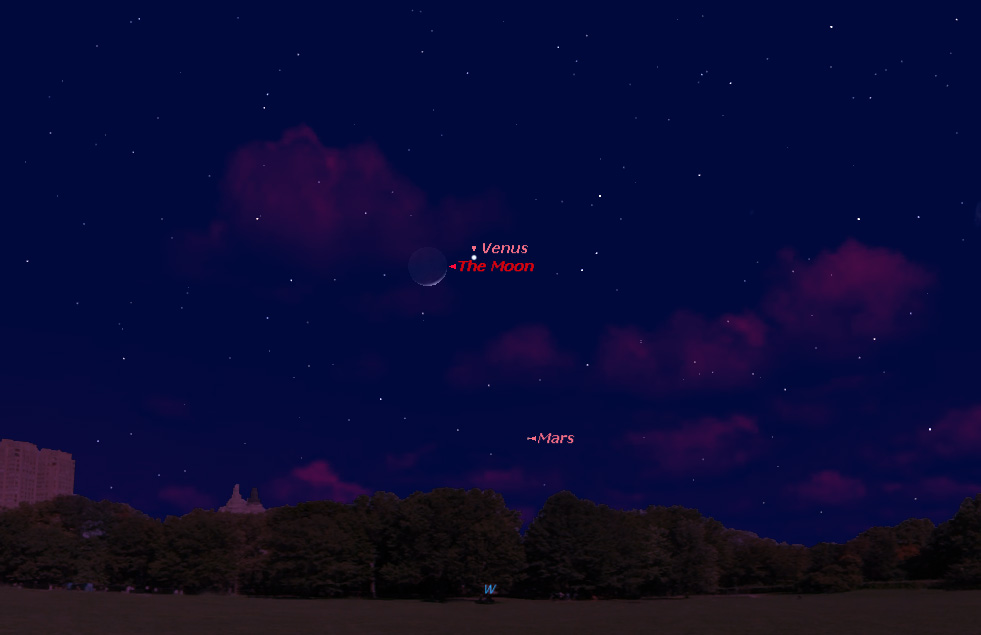
As darkness falls tonight (March 22), be sure to take a look low toward the western part of the sky for yet another beautiful celestial tableau formed by a lovely crescent moon and the brilliant planet Venus. Weather permitting, you will see Venus will appear to hover to the right of and just a bit above the moon.
A rendezvous of Venus and the moon this occurs on roughly a monthly schedule. Indeed, if Venus were stationary and did not appear to move against the star background, then a Venus-moon encounter would occur every 27 days, 7 hours and 43 minutes. This is called a "sidereal month" which is the length of time it takes the moon to circle the Earth once, using the background stars as a reference point.
Since Venus and the moon were together (along with much fainter Mars) on Feb. 20, we might have expected a return engagement this past Thursday (March 19) if we tried to apply this "sidereal month rule” to this schedule. [Amazing Photos: Venus, the Moon and Mars Together]
Of course that rule didn't work because Venus is not stationary, but moving in its own orbit around the sun. From our earthly viewpoint, Venus, in fact, has appeared to shift considerably to the east against the star background. Back on Feb. 20, Venus was in the constellation of Pisces, the Fishes. But on Thursday it will have appeared to shift more than 35º to the east where it currently resides in the constellation of Aries, the Ram.
Playing catch up
So the moon had to travel that much more across the sky to catch up to Venus. Since the moon appears to move across the sky at roughly 13 degrees per day, it needs three more days to catch up to Venus. That takes us to tonight, where once again we will be treated to an eye-catching sight in our western twilight sky between the two brightest objects in the night sky.
Incidentally, another factor that must also be considered is our own Earth’s movement around the sun. If, in fact, you looked for the crescent moon on Thursday evening, you wouldn't have been able to see it because it was less than half a day from New phase (and a total solar eclipse on March 20) and hence too near to the sun to have been seen. That's because during the 27 days that had elapsed since July 10, the Earth's movement around the sun would have caused the sun's position in the sky to shift to the east as well … in this case, right into the very same region that Venus and the moon occupied on Feb. 20.
They're back …
By Sunday, however, the moon will be well clear of the sun and readily visible in the western sky with Venus.
Get the Space.com Newsletter
Breaking space news, the latest updates on rocket launches, skywatching events and more!
Venus shines like a beacon through the fading dusk; the first planet to look for when the sun goes down. At sunset, face west and look about one-third up from the horizon to the point directly overhead (about 30 degrees above the western horizon) to find the moon and Venus. For comparison, your closed fist held at arm's length covers about 10 degrees of the night sky. So, the equivalent of three closed fists up from the horizon will take you to Venus and the moon.
Later in twilight, Venus will become plainly visible. In a telescope, Venus' disk is dazzling, yet unimpressive. It's still relatively small and 81-percent illuminated — a gibbous (less full) phase.
And lastly, if clouds obscure your view of Venus and the moon tonight, don't fret. Your next opportunity to see them together again will come on Tuesday, April 21.
Editor's note: If you capture an amazing photo of Venus and the moon together and would like to share it for a possible story or gallery, send comments and images in to managing editor Tariq Malik at: spacephotos@space.com.
Joe Rao serves as an instructor and guest lecturer at New York's Hayden Planetarium. He writes about astronomy for Natural History magazine, the Farmer's Almanac and other publications, and he is also an on-camera meteorologist for News 12 Westchester, N.Y. Follow us @Spacedotcom, Facebook and Google+. Original article on Space.com.
Join our Space Forums to keep talking space on the latest missions, night sky and more! And if you have a news tip, correction or comment, let us know at: community@space.com.

Joe Rao is Space.com's skywatching columnist, as well as a veteran meteorologist and eclipse chaser who also serves as an instructor and guest lecturer at New York's Hayden Planetarium. He writes about astronomy for Natural History magazine, Sky & Telescope and other publications. Joe is an 8-time Emmy-nominated meteorologist who served the Putnam Valley region of New York for over 21 years. You can find him on Twitter and YouTube tracking lunar and solar eclipses, meteor showers and more. To find out Joe's latest project, visit him on Twitter.









